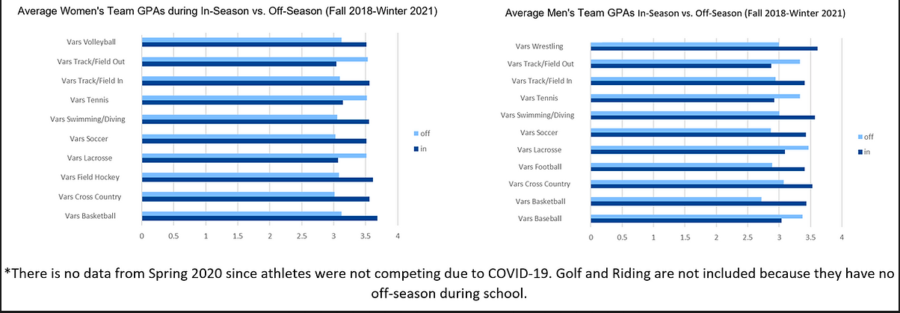W&L student-athletes perform better academically while in season
Pressures to effectively manage time and prove academic success motivate student-athletes to excel
Average team GPA improves when student-athletes are in-season versus when they are not. Graphic created by Stefanie Chiguluri, ‘24.
March 15, 2022
It’s still dark outside. Silence fills the Washington and Lee University hallways and sidewalks as student-athletes make their way to an early morning lift while the rest of campus sleeps. Next thing you know, they are sitting next to you at your 8:30 a.m. class.
“When [other students] tell you that they’re tired, and worn out, and they don’t know how to get through, you’re just looking at them like ‘did you just wake up at 6 a.m. and have lift, or did you just run those 110’s on the field? Did you do all that?’” Jalen Todd, ’25, a football player, said.
Student-athletes at Washington and Lee must find a way to balance their rigorous athletic schedules with challenging academic work. At the Division III level, teams prioritize academics over sports because students come for an education first — especially at Washington and Lee, which is ranked 11th for Best National Liberal Arts schools by U.S. News and World Report.
“I feel like academics is definitely a top priority for our team and for our coach,” golfer Laetitia Roenger, ’25, said. “It’s an academically rigorous school and we all try to do well.”
Volleyball player Maddie Weller, ’25, agreed.
“We’re focused on being students before athletes,” Weller said.
This prioritization of education contributes to a university-wide trend: that student-athletes perform better academically when they are in-season rather than off-season. Student-athletes say they are forced to use their time more wisely when they are in season.
“I have more of my day scheduled so that I have to do certain things, and I can’t put them off,” said swimmer Mason Davis, ’24.
Most teams at Washington and Lee do show better academic performance while in-season according to their collected GPA data.
Student-athletes are treated the same as non-student-athletes in their classes, which motivates them to do well beyond their athletic performance. This is especially true during their season, when they must prove they can handle both roles.
“We’re treated exactly the same as everyone else is,” Todd said. “In some cases, it’s actually a lot harder to maintain a good GPA as an athlete, just in my opinion and talking to other athletes, and knowing that some of them are majoring in those really hard majors.”
Non-student-athletes recognize that student-athletes here don’t ultimately see their sport as their end goal.
“When you’re here, you’re just really playing for the love of the sport,” said Douglas Heebe, ’25. “You just want to keep going with something you’ve done your entire life. Whereas D-I it’s like ‘this is my entire life.’”
Student-athletes recognize that playing at the Division III level gives them a unique opportunity to pursue any major.
“I do think that D-III is still a lot of work, which I don’t think I fully appreciated beforehand,” said field hockey player Jennifer Lerner, ’24. “But I think D-I is a little bit more limiting in the fact that I probably couldn’t do biochemistry. I probably couldn’t do every major I wanted to do.”
University of Virginia swimmer and Olympian Alex Walsh said that pursuing a computer science major is bizarre at the Division I level.
“People know I’m an athlete, but I’m happy people can see me in these more notoriously difficult classes at UVA,” said Walsh, “I feel happy knowing that I’m breaking the stereotype and that not all athletes aren’t applying themselves at school.”
Student athletes at Washington and Lee effectively manage both athletics and academics, and their peers respect them for it.
Non-student-athletes also understand that student-athletes are managing the same workload with more limited time.
“I’m shocked that they can keep up with all of it,” said Charlene Nsengimana, ’24.



